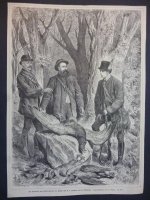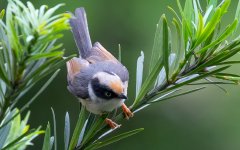Psaltria sophia
• the invalid "
Psaltria Sophia" DAVID 1874 (
here, in text), from "Kiang-si", China (no dedication) [Syn.
Psaltria exilis TEMMINCK 1836], described by the French missionary Abbé (Father) Armand David (1826–1900).
Could it possibly be from the Greek
sophia σοφία (wisdom), as in (Sophia, capitalized) the Personification of Wisdom (Koinē Greek: Σοφία), as of
here ...
? Just an idea.
If not, I would try to find his Mother. Years would/could/might fit. As
Abbé/
Père (Father) David was a (devout) Catholic Priest, I don't expect there's a Wife to be found (nor any kids/daughters)

. According to French
Wiki Armand David was born "
7 septembre 1826 à Espelette en Pays", (
i.e. Espelette/
Ezpeleta), in the Southwest of France (on the very Border to the Basque Country, today's Spain), Son of "
Dominique David, est médecin et maire du village". Surely a wife of a
maire (Mayor) ought to be possible to find?
His mother was called Rosalie on his birth record ([
here], hoping the link remains valid). (And she is given as "Rosalie-Marie" [
here]. No Sophie among his direct relatives either, apparently.)
Of course, "
Psaltria Sophia" is nude in David 1874, which is the only source referenced in the Richmond Index. It was made available in the second volume of David's
Journal de mon troisième voyage d'exploration dans l'empire chinois, published in 1875: [
here].
This name is certainly not a synonym of
Psaltria exilis, as currently suggested in the
Key. (
P. exilis is a Javanese endemic.) This is a bird David caught in Tsitou, "Kiang-si" = Jiangxi, China. He described it as having the size and shape of
Psaltria concinna (now
Aegithalos concinnus), but with rufous restricted to the front part of the head, the black throat patch lacking and replaced by a necklace of small black spots, and whitish instead of rufous-toned underparts. He thought the bird was an adult and proposed the name in case it proved indeed to be a new species; but he was nevertheless not fully certain it was not a young
Ae. concinnus -- a possibility that his description does not appear to exclude. (He added that if the bird proved to be a young
concinnus, this would bring the proof that Paridae go through an immature plumage before reaching their adult plumage, and would also justify revisiting the status of
Mecistura vinacea Verreaux, which might then be a young
Mecistura glaucogularis Gould.)
Hellmayr listed
Psaltria sophia in the synonymy of
Ae. concinnus [
here]. (And, [
here] -- as [wisely

?] predicted by David in case this proved to be the case -- he also listed
Mecistura vinacea as a synonym of
Ae. caudatus glaucogularis.)
Note that David did not use a genitive for this name (while he did in every other eponym he proposed elsewhere, so far as I can find), and in 1875 he wrote it with a lower-case
s (while eponyms in this book were consistently capitalized -- e.g., see the species list on
p.39 et seq. ; he may conceivably have had a better control of this type of thing in his own book than in the 1874 journal article). Is this really an eponym ?







